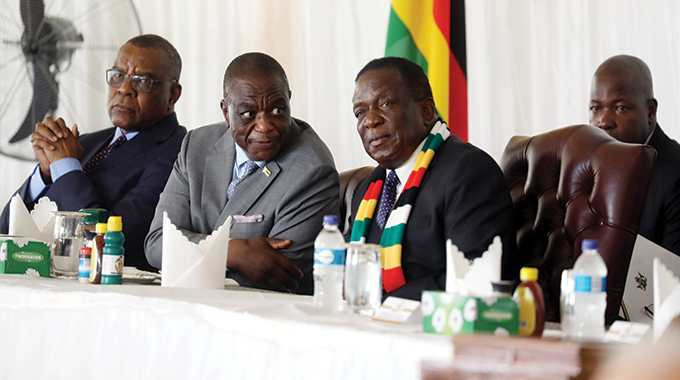Mangudya re-assures nation on fuel situation

Golden Sibanda, Harare Bureau
RESERVE Bank of Zimbabwe (RBZ) governor Dr John Mangudya has given the nation assurance that the fuel situation should start improving before the end of this month.
He said an improvement in the fuel situation was anticipated on the back of widespread interventions the central bank and Government have put in place to increase imports.
Dr Mangudya said Zimbabwe had adequate hard currency to import fuel, pointing out that queues that continue to characterise most filling stations across the country reflected the time lag of bank processes and actual deliveries.
The central bank chief also indicated that in instances some of the fuel dealers did not have sufficient RTGS dollars to monetize their letters of credit used to finance fuel imports. This comes as dealers now need more local currency, following the liberalisation of the exchange rate, to match any amount of foreign currency they may receive for fuel imports.
Previously, fuel importers would get allocations of the hard currency from the central bank at the rate of 1 to1 between the US dollar against local forms of money (RTGS) and bond notes.
Most of the fuel is now imported into Zimbabwe using letters of credit (LCs)-financial instruments for securitising and financing bulk imports such as fuel. LCs are guaranteed by the African Export and Import Bank.
The governor said it was due to the time lag between establishing an LC, having the LC confirmed by an international bank, evaluated and confirmed by bank advisor of the foreign oil supplier and the time until confirmation by the supplier for release of fuel is received, which caused fuel gaps in supply and availability.
Dr Mangudya said the shortage of fuel in the country, after the introduction of the LC framework for importation of fuel, was no longer a result of foreign currency shortage in the country. He said this when he appeared before Parliamentary Portfolio Committee on Energy and Power, chaired by Uzumba Member of Parliament, Cde Simbaneuta Mudarikwa.
Dr Mangudya said the RBZ had established a system enabling dealers to obtain letters of credit in order to import adequate amounts of fuel required by the domestic economy.
Asked what strategy the central bank had in place to bridge the supply gaps caused by the logistical issues that in between the approval and evaluation processes involving LCs, Dr Mangudya said the bank was making further supply interventions, but indicated that they were also persuading various suppliers to expedite their processes.
As such, the central bank chief said some of the fuel for which an amount of US$91 million worth of letters of credit-enough to import 150 million litres-was made available through various schemes was only being delivered now.
“The bulk of the fuel that is being purchased now is through letters of credit (LC). A letter of credit is an instrument used by banks to securitise and to finance things like fuel and other commodities and give Zimbabwe a time span to pay.
“In the LC (principle), there are things called time lags. The day you establish an LC and the day you get the product, there are some time lags,” he said. “So the difference between the payment of US$91,94 million (for instance), which was supposed to bring 150 million litres in that month and the day of delivery (is the time lag), (because) not all that fuel came in the same month of January,” he added.
The central bank chief said the decision by Government to increase fuel prices in January had worked magic with consumption dropping from average of 150 million per month to between 130 million and 120 million litres.
Dr Mangudya said the bank was now making allocations for fuel imports, given the price elasticity of fuel, on the basis of the anticipated amount of fuel needed in the economy.
“In February on the basis of that anticipation, we made available US$80,86 million. If you divide again by US0,6 cents it gives you 135 million litres. So it means the amount made available should be sufficient to purchase fuel required by this economy. If you now go to the amount released into the market for the two months; in January the releases into the market were about 104 million litres and another 104 million litres in February.
“So it means that the fuel that we paid for in January of around 150 million and 135 million litres and the releases from Msasa into the service stations for consumers; you take the 130 million minus 104 million litres, you now see why there are queues. That discrepancy, of about 16 million litres, is the one that causes now the fuel queues. Question is how come the amount which was paid for fuel was 150 million and the release was only 104 million litres, that is the question; that’s where the queues come.
But still MP Mudarikwa wanted to know why the process of establishing the LC, having it confirmed by the guarantor for Zimbabwe’s major imports (Afreximbank) still resulted in delays to deliveries when the fuel is in bond at Msasa.
“In banking, you have a bank that establishes an LC, which is our local bank so it means that the oil marketing company goes to their bank and establish a letter of credit under the (fuel import) facilities that we have put in place.
“At the local bank that LC needs now to go for confirmation, which is done by an international bank, by Afreximbank, which needs to confirm that the LC has been established by the local bank (and is bankable),” Dr Mangudya said. “When it has been confirmed it now means it has been guaranteed and instrument called LC is now value for money.
Dr Mangudya said only after the supplier has seen an approved LC, will a notification be given to the National Oil Company of Zimbabwe to release fuel at the Msasa storage facilities.










Comments